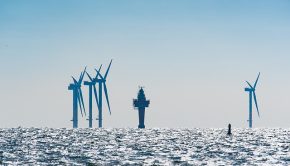GWEC: Offshore wind is estimated to surge to 234 GW by 2030 –
GWEC: Offshore wind is estimated to surge to 234 GW by 2030 –
Global offshore wind capacity is estimated to surge to over 234 GW
by 2030 from 29.1 GW at the end of 2019, led by growth in the Asia-Pacific
region and continued growth in Europe, according to a new report from the
Global Wind Energy Council (GWEC).
GWEC recently released the second edition of its Global Offshore
Wind Report, a comprehensive overview of the global offshore wind sector with
the latest data and analysis on market growth, industry forecasts to 2030 and
data-based insights on emerging markets. The report also includes lessons learned
on support schemes, industrial development and job creation, grid connection,
cost reduction and supply chain, as well as health and safety to further drive
growth of the market.
The report found that 2019 was the best year on record for
offshore wind, with 6.1 GW of new capacity added globally, bringing total
global cumulative installations to 29.1 GW. China remains in the number one
spot for the second year in a row for new installations, installing a record
2.4 GW, followed by the UK at 1.8 GW and Germany at 1.1 GW. While Europe
continues to be the leading region for offshore wind, countries in the
Asia-Pacific region, as well as the US market, will be regions of significant
growth in the next decade.
GWEC Market Intelligence forecasts that through 2030, more than
205 GW of new offshore wind capacity will be added globally, including 6.2 GW
of floating offshore wind. This represents a 15 GW increase from the forecasts
in GWEC Market Intelligence’s pre-COVID forecast.
The global offshore market has grown an average of 24% annually
since 2013. Europe remains the largest market for offshore wind as of the end
of 2019, making up 75% of total global installations. Europe continuous to be a
leader in offshore wind, with a 450 GW goal by 2050 driven by the UK,
Netherlands, France, Germany, Denmark and Poland.
North America currently has just 30 MW of offshore wind capacity
in operation in 2019, but deployment is expected to accelerate in the coming
years with 23 GW forecasted to be installed by 2030. This growth will mainly come
from the budding industry in the US, and we can expect to see utility-scale
projects coming online by 2024 in the US.
The report highlights increased activity level in the Asia-Pacific
region, led by China where 52 GW of new offshore wind capacity is expected to
be installed by 2030. Taiwan is set to become the second-largest offshore wind
market in Asia after Mainland China, with a goal of 5.5 GW by 2025 and an additional
10 GW by 2035. Also, Vietnam, Japan and South Korea are expected to install 5.2
GW, 7.2 GW and 12 GW of offshore wind capacity respectively.
GWEC is working actively to drive the growth of offshore through
the work of its Task Forces and members, including Global Offshore Wind, Japan
Offshore Wind and Floating Offshore Wind. GWEC is also closely working with The
World Bank Group and ESMAP on their Offshore Wind Development Program.
The full Global Offshore Wind Report is available for download here.
Ben Backwell, CEO at GWEC commented: “Offshore wind is truly going global, as governments around the world recognize the role that the technology can play in kickstarting post-COVID economic recovery through large-scale investment, creating jobs and bringing economic development to coastal communities. Over the coming decade we will see emerging offshore markets like Japan, Korea and Vietnam move to full deployment, and see the first offshore turbines installed in a number of new countries in Asia, Latin America and Africa.
“Furthermore, 1 GW of offshore wind power avoids 3.5 MT CO2 –
making it the most effective available large-scale technology to avoid carbon
emissions and displace fossil fuels in many geographies”.
Feng Zhao, GWEC Strategy Director says: “The industry’s outlook has grown more promising as more and more countries around the world are waking up to the immense potential of offshore wind. As the market continues to grow, innovations in the sector such as floating offshore wind, larger and more efficient turbines, as well as Power-to-X solutions will continue to open new doors and markets for the sector and place the offshore industry in an increasingly important position to drive the global energy transition”.
“Offshore wind has already proven itself as an affordable, scalable, zero-carbon technology, and maximizing the growth potential of the industry has depended on collaborative action between governments and industry for market design, to set clear capacity targets, undertake forward-looking planning for infrastructure development and workforce requirements,” he added.
APPENDIX
Top 5 markets for new offshore installations in 2019

- China – 2.4 GW
- The UK – 1.8 GW
- Germany – 1.1 GW
- Denmark – 374 MW
- Belgium – 370 MW
Top 5 markets for cumulative offshore installations in 2019

- The UK – 9.7 GW
- Germany – 7.5 GW
- China – 6.8 GW
- Denmark – 1.7 GW
- Belgium – 1.6 GW
Top 5 markets forecasted for cumulative offshore wind installations by 2030

- China – 58.8 GW
- The UK – 40.3 GW
- US – 22.6 GW
- Germany – 20 GW
- Netherlands – 11.4 GW








